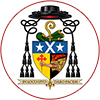What is the Transfiguration?
It’s a confirmation of the identity of Jesus as God’s Son: confessed by Peter (Lk 9:20), predicted by the prophets, prefigured in the law. The prophets are represented by Elijah, the law by Moses. The 3 chosen witnesses stand for all the Apostles, and for the whole Catholic Church.
The Transfiguration demonstrates also that God is with Jesus throughout his earthly ministry. God honours him; God ratifies all he says and does; God is involved in all the details of his life. God also is with him in pointing ever towards his final destiny: his sacrificial and redemptive death.
The Transfiguration is a manifestation, also, of the divinity of Jesus. More vividly than the other Gospel writers, St. Luke speaks of the brilliance of the light shining from Jesus. It’s like lightning: too dazzling to look at directly. His face shines, but also his clothes shine. So the light comes not from the outside in, as if a spot light were being played on him, but from the inside out. The divine nature of Jesus lights up, transfigures whatever it touches. This is always true, whether we perceive it or not.
The Transfiguration is also a revelation of Christian prayer, and of the Christian life.
St. Luke says that Jesus went up the mountain to pray.
What happens then when we pray?
We enter God’s presence. We come before the all holy, the all powerful, the Three-in-One, Father, Son and Holy Spirit. We thereby enter also the fellowship of the Saints, and of the whole Church. The effect of that, for us also, is transfiguration. Normally, as with Jesus, this is concealed from us. Sometimes though the veil is momentarily lifted, and then it’s obvious that something divine, something holy, something utterly beautiful, utterly wonderful is here.
In prayer also we listen to God’s voice. We hear it above all through the words of Jesus. We open ourselves to him in faith and obedience. We deliberately and explicitly put our trust in Jesus: his words, his example, his promises; his care for us; his love of us. And from our prayer we draw courage to face whatever we have to face: any suffering whatever, and finally our own death.
A cloud came to cover the scene: and it covered the disciples present too. Frequently in the Old Testament a cloud is a sign of God’s presence and glory. We could say here that it’s a sign especially of the Holy Spirit. But it’s a paradoxical sign, because it’s darkness rather than light. It conceals, rather than reveals. It causes not consolation but fear. For God is a mystery far beyond our understanding. He is bigger, greater, more powerful, and also more good, than anything we can imagine or comprehend. We cannot perceive God with any of our senses. God is not like anything whatever of which we have experience. Yet we are in God, and God is in us. God comes to us, communicates with us, reveals himself to us, shares his own life with us, through Jesus Christ our Lord, and especially though his saving Passion and death.
Each year on the Second Sunday of lent the mystery of the Transfiguration is presented to us, to help us through our lent; to help prepare us for Easter.
Lent symbolises the whole of our life here below, in this valley of tears. Often of necessity we walk amid darkness and difficulty. But we are not like those who have no hope. Always we have the companionship of Jesus. He is present with us, even though we do not see him: in his humanity, and in his divinity. And always we live in anticipation of Easter. That is a sign of our final share in his resurrection from the dead, and in his eternal and heavenly glory.
